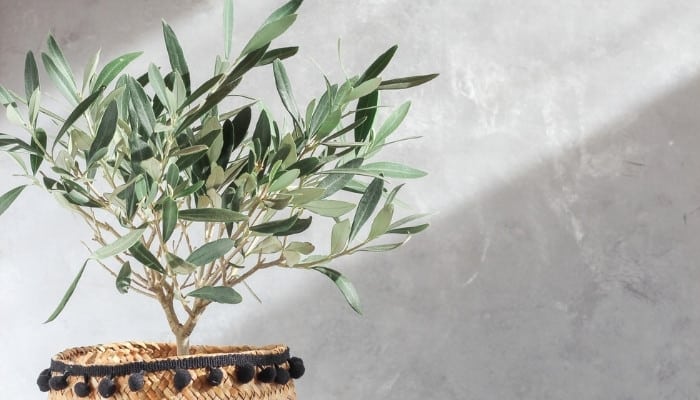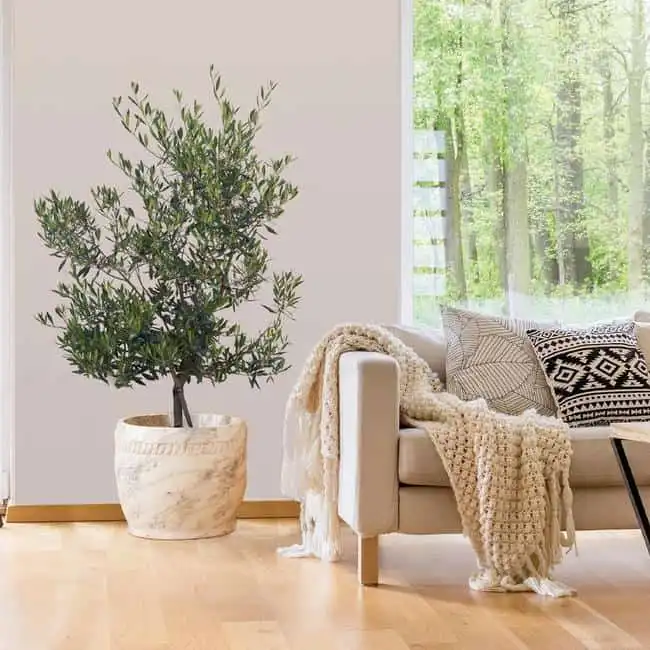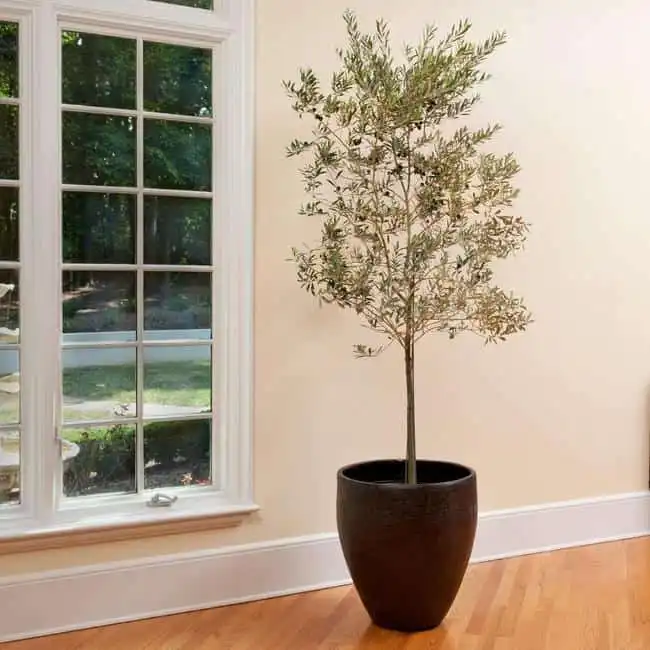Olive trees are not only a source of delicious fruit and high-quality cooking oil, but they also make lovely additions to any potted plant collection.
In addition to the fruiting kind, there are also species that are cultivated strictly for ornamental purposes that don’t fruit.
That means you can grow a potted olive tree with no fuss or mess that comes with other fruiting trees.
Can you grow an olive tree indoors? Olive trees are commonly grown indoors around the world. They require particularly rocky and well-draining soil, plenty of bright light, and temperatures well above freezing. Olive trees also need to be fertilized twice per year and repotted every two years.
Read on and explore this guide to growing and caring for indoor olive trees for everything you need to know.
How To Grow an Olive Tree Indoors
Growing olive trees indoors isn’t much different than growing other house plants and trees.
That said, as with most plant or tree species, there are several important aspects about these trees that you need to know if you want to grow them indoors successfully.
Container & Soil for Growing an Olive Tree Indoors
Unlike many of your favorite indoor trees, olive trees require a slightly different type of soil and container. Olive trees thrive in a rough type of soil mix that includes sand and rocks or gravel.
The most important aspect of soil for olive trees is that it needs to be very well-draining and not stay too moist in between waterings.
As far as the best container for an olive tree goes, avoid plastic at all costs.
Plastic pots, even with proper drainage holes, retain higher amounts of water than other materials, and olive trees may not survive with excess water weakening their roots.
Containers made from wood, clay, or ceramic materials are the most preferred for olive trees.
Lighting & Temperature Requirements for Olive Trees
Olive trees originate from Mediterranean regions. That means they prefer long and hot summers, and short, cold winters (not freezing winters).
As long as the temperature is between 50°F to 80°F (roughly 70°F) olive trees will thrive. That said, they can tolerate temperatures of up to 95°F for a short period of time.
During the late spring and summer, it is good practice to set your olive tree outside and let it soak up the warm weather.
Also, olive trees must be exposed to temperatures of around 15°F to 20°F for a few weeks during the winter if you want them to fruit properly.
Watering & Fertilizing Olive Trees in Pots
Indoor olive trees in pots need more frequent watering sessions than their outdoor counterparts. That’s because they don’t have the underground water table to keep them hydrated in between waterings.
Olive trees should be watered only after the top several inches of soil have dried out almost completely. When watering, keep the water coming until the soil is entirely soaked.
If you’re using the right type of soil (a rocky mix) the water will drain quickly but leave the interior of the soil thoroughly moist.
Olive trees in pots also require a good deal of fertilizing compared to other fruiting trees.
They need to be fertilized at least twice per year, in the spring (April or May) and again in the middle of the summer (before the end of July or August).
Pruning an Indoor Olive Tree
Indoor olive trees require much more frequent pruning (each year), rather than once every two or three years as their outdoor brethren do.
The best time of the year to prune your potted olive tree is late winter. Early spring is another good time to prune.
When you prune your olive tree, simply cut all branches off that are pointing down. Follow up by removing any branches that are growing from the trunk or base of the tree.
When To Repot an Indoor Olive Tree
Olive trees growing in containers need to be repotted at least once every two to three years. The best time to repot an indoor olive tree is April or May (late spring).
That way, the cold weather is over and the tree is beginning to produce new growth.
When potted during the late spring olive trees have enough time to develop new roots and become hardier before winter weather returns.
However, if your olive tree is suffering from a condition such as root rot or an infestation of pests, you need to repot it immediately (regardless what time of year it is).
How Long Can an Olive Tree Live in a Pot?
Olive trees in pots may live nearly 10 years (8 or 9 years on average). If you plan for your olive tree to last even half that long, it will need a large enough pot and to be repotted every couple of years (at least).
Your olive tree also needs to receive enough sun and moisture consistently throughout the years. One or two seasons of neglect and an olive tree can easily die.
Best Olive Tree Varieties To Grow Indoors
Now that you know the basics about growing olive trees indoors, let’s discuss the best varieties to grow indoors.
Amfissa
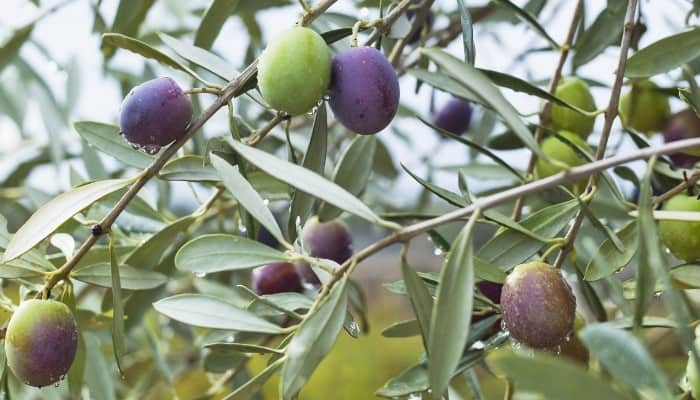
This variety of olive tree is excellent for indoor growth. They don’t take up much space, and they thrive in a wide temperature range, making them easy to care for.
Amfissa olive trees are among the best species for making olive oil from their fruit.
- Size: 20 to 30 feet
- Bears Fruit: Yes
- Native Region: Greece
- Temperature Range: 20°F to 90°F
Arbequina
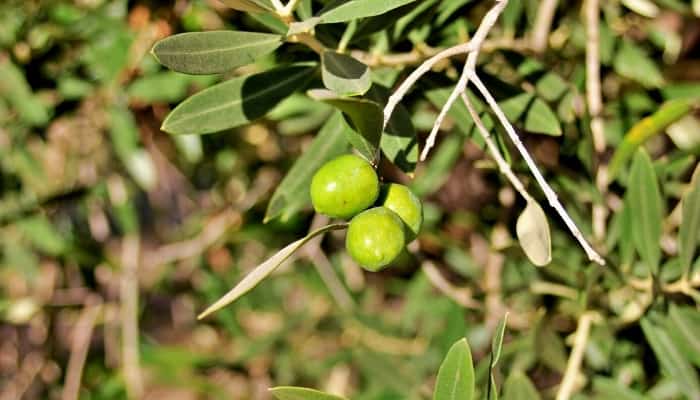
The Arbequina is a Spanish olive tree that grows indoors exceptionally well. Outdoors they reach heights of 20 feet, but inside they top out just 3-4 feet above the pot they are growing in.
Another really big bonus to the Arbequina variety is that they may produce fruit as soon as their first year.
- Size: 15 to 20 feet
- Bears Fruit: Yes
- Native Region: Spain
- Temperature Range: 20°F to 90°F
Koroneiki
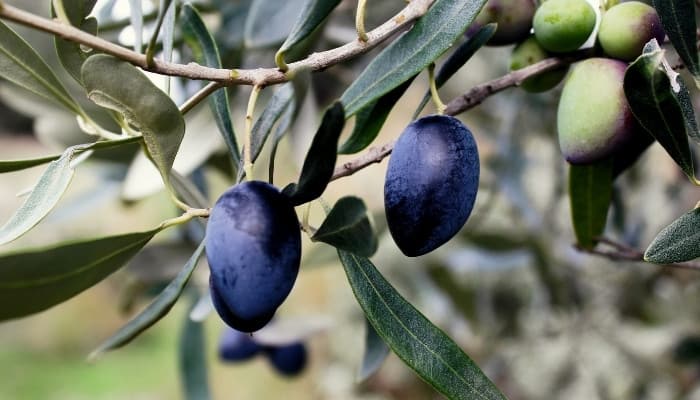
An olive tree that originates from the southernmost orchards of Greece, the Koroneiki is another really great species for growing indoors.
More so than almost any other variety, Koroneiki olive trees are extremely resistant to drought. That means if you tend to forget watering from time to time, this may be the best olive tree to grow indoors for you.
- Size: 15 to 20 feet
- Bears Fruit: Yes
- Native Region: Greece
- Temperature Range: 25°F to 95°F
Manzanilla
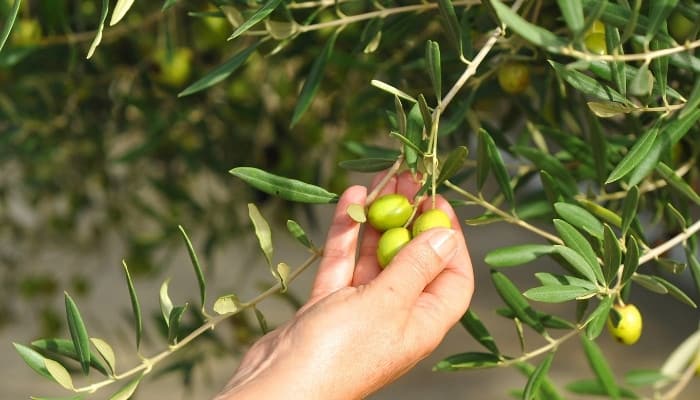
One of the slowest growing types of indoor olive trees, the Manzanilla is a North American species that finds its roots in the Western states.
If you grew up in America, Manzanilla are the olives you’re familiar with (the green ones stuffed with orange pieces of pimento).
They require less attention, including pruning, but need to be kept away from drafty windows and doors.
- Size: 20 to 30 feet
- Bears Fruit: Yes
- Native Region: Western North America
- Temperature Range: 25°F to 95°F
Mission
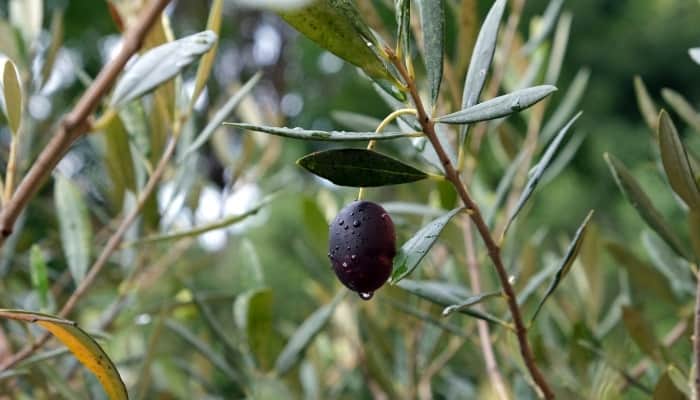
Reportedly originating in Spain, the Mission olive tree is best known for being cultivated in California since the late 1700s.
They are one of the most cold-resistant olive trees around, so if you like to run the AC in your home, you might consider this species!
Additionally, the fruit from Mission trees is excellent for eating or making oil.
- Size: 10 to 30 feet
- Bears Fruit: Yes
- Native Region: Spain
- Temperature Range: 10°F to 90°F
1-2-foot or 3-4-foot starter mission olive trees, shipped right to you!
1-2-foot or 3-4-foot starter greek olive trees, shipped right to you!
Problems With Olive Trees in Pots
Several of the most common problems with growing olive trees in pots include:
Pot Bound Roots
Olive trees need repotting once every 2 to 3 years (at the very least). If not, the roots of the olive tree become too large for the pot and may no longer grow.
The Wrong Soil
Using the wrong soil is probably the biggest mistake you can make with your indoor olive tree.
The soil should be sandy, rocky, and drain extremely well. Any other type of soil may cause your tree to become sick or even die.
Not Enough Light
Placed in an area lacking proper light, your olive tree will not thrive, let alone fruit properly. It may not even live for long.
A Drafty Location
Another common problem with growing olive trees indoors is keeping them somewhere that they are exposed to cold drafts.
For many species, a bit of cool air is a good thing – but only in measured doses (and during the winter and early spring only).
The Wrong Type of Pot
One of the most commonly overlooked issues with olive trees that aren’t doing too well is the type of pot they are planted in.
If the pot is plastic, the olive tree is doomed. Clay and wood are the best type of pots for olive trees because they allow for better draining.
Related Questions:
How Long Do Olive Trees Live?
Olive trees live for extraordinary long amounts of time compared to many fruit trees. On average, olive trees live between 300 and 600 years.
However, the oldest olive trees in the world are between 1,000 and 3,000 years old.
Which Olive Trees Do Not Produce Fruit?
There are several species of olive trees that do not produce fruit. The most well-known of these non-producing olive trees include Manzanillo, Mission, and Wilsonii.
In addition, indoor olive trees that aren’t properly pollinated do not produce fruit.
A Final Word About Growing Olive Trees Indoors
The answer to “can you grow an olive tree indoors?” is a firm “yes.” Olive trees may thrive indoors just as thoroughly as they do outside, but they definitely require a bit more care than some indoor fruit trees.
Hopefully our guide answers all of your questions about growing an olive tree indoors. Please feel free to refer back to this guide as often as you see fit while learning how to grow and care for your indoor olive tree!

